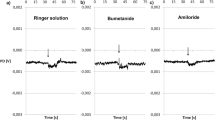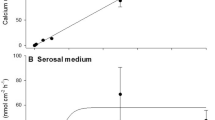Summary
For elucidation of the functional organization of frog skin epithelium with regard to transepithelial Na transport, electrolyte concentrations in individual epithelial cells were determined by electron microprobe analysis. The measurements were performed on 1-μm thick freeze-dried cryosections by an energy-dispersive X-ray detecting system. Quantification of the electrolyte concentrations was achieved by comparing the X-ray intensities obtained in the cells with those of an internal albumin standard.
The granular, spiny, and germinal cells, which constitute the various layers of the epithelium, showed an identical behavior of their Na and K concentrations under all experimental conditions. In the control, both sides of the skin bathed in frog Ringer's solution, the mean cellular concentrations (in mmole/kg wet wt) were 9 for Na and 118 for K. Almost no change in the cellular Na occurred when the inside bathing solution was replaced by a Na-free isotonic Ringer's solution, whereas replacing the outside solution by distilled water resulted in a decrease of Na to almost zero in all layers. Inhibition of the transepithelial Na transport by ouabain (10−4 m) produced an increase in Na to 109 and a decrease in K to 16. The effect of ouabain on the cellular Na and K concentrations was completely cancelled when the Na influx from the outside was prevented, either by removing Na or adding amiloride (10−4 m). When, after the action of ouabain, Na was removed from the outside bathing solution, the Na and K concentration in all layers returned to control values. The latter effect could be abolished by amiloride.
The other cell types of the epithelium showed under some experimental conditions a different behavior. In the cornified cells and the light cells, which occurred occasionally in the stratum granulosum, the electrolyte concentrations approximated those of the outer bathing meium under all experimental conditions. In the mitochondria-rich cells, the Na influx after ouabain could not be, prevented by adding amiloride. In the gland cells, only a small change in the Na and K concentrations could be detected after ouabain.
The results of the present study are consistent with a two-barrier concept of transepithelial Na transport. The Na transport compartment comprises all living epithelial layers. Therefore, with the exception of some epithelial cell types, the frog skin epithelium can be regarded as a functional syncytium for Na.
Similar content being viewed by others
References
Aceves, J., Erlij, D. 1971. Sodium transport across the isolated epithelium of the frog skin.J. Physiol. (London) 212:195
Andersen, B., Zerahn, K. 1963. Method for non-destructive determination of the sodium transport pool in frog skin with radio sodium.Acta Physiol. Scand. 59:319
Bauer, R., Rick, R. 1977. A computer program for the analysis of energy dispersive X-ray spectra of thin sections of biological soft tissue.X-ray Spectrom. (in press)
Carasso, N., Favard, P., Jard, S., Rajerison, R.M. 1971. The isolated frog skin epithelium. I. Preparation and general structure in different physiological states.J. Microsc. (Paris) 10:315
Cereijido, M., Curran, P.F. 1965. Intracellular electric potentials in frog skin.J. Gen. Physiol. 48:543
Cereijido, M., Reisin, I., Rotunno, C.A. 1968. The effect of sodium concentration on the content and distribution of sodium in the frog skin.J. Physiol. (London) 196:237
Cereijido, M., Rotunno, C.A. 1967. Transport and distribution of sodium across the frog skin.J. Physiol. (London) 190:481
Cereijido, M., Rotunno, C.A. 1968. Fluxes and distribution of sodium in frog skin. A new model.J. Gen. Physiol. 51:280
Curran, P.F., Herrera, F.C., Flanigan, W.J. 1962. The effect of Ca and antidiuretic hormone on Na transport across frog skin. II. Sites and mechanisms of action.J. Gen. Physiol. 46:1011
Cuthbert, A.W. 1972. A double (series) pump model for transporting epithelia.J. Theor. Biol. 36:555
Dörge, A., Gehring, K., Nagel, W., Thurau, K. 1974. Intracellular Na+−K+ concentration of frog skin at different states of Na-transport.In: Microprobe Analysis as Applied to Cells and Tissues. Th. Hall, P. Echlin and R. Kaufmann, editors. p. 337. Academic Press, London-New York
Dörge, A., Nagel, W. 1970. Effect of amiloride on sodium transport in the frog skin: II. Sodium transport pool and unidirectional fluxes.Eur. J. Physiol. 321:91
Dörge, A., Rick, R., Gehring, K., Mason, J., Thurau, K. 1975. Preparation and applicability of freeze-dried sections in the microprobe analysis of biological soft tissue.J. Microsc. Biol. Cell,22:205
Dörge, R., Rick, R., Gehring, K., Thurau, K. 1977. Preparation of freeze-dried cryosections for quantitative X-ray microanalysis of electrolytes in biological soft tissues.Pfluegers Arch. (in press)
Ehrenfeld, J., Masoni, A., Garcia-Romeu, F. 1976. Mitochondria-rich cells of frog skin in transport mechanisms: Morphological and kinetic studies on transepithelial excretion of methylene blue.Am. J. Physiol. 231:120
Eigler, J., Kelter, J., Renner, E. 1967. Wirkungscharakteristika eines neuen Acylguanidins —Amiloride-HCL (MK 870) — an der isolierten Haut von Amphibien.Klin Wschr. 14:737
Engbaek, L., Hoshiko, T. 1957. Electrical potential gradients through the frog skin.Acta Physiol. Scand. 39:384
Erlij, D. 1971. Salt transport across isolated frog skin.Phil. Trans. R. Soc. London B 262:153
Farquhar, M.G., Palade, G.E. 1964. Functional organization of amphibian skin.Proc. Nat. Acad. Sci. USA 51:569
Farquhar, M.G., Palade, G.E. 1965. Cell junction in amphibian skin.J. Cell. Biol. 26:263
Farquhar, M.G., Palade, G.E. 1966. Adenosine triphosphatase localization in amphibian epidermis.J. Cell. Biol. 30:359
Frazier, H.S., Dempsey, E.F., Leaf, A. 1962. Movement of sodium across the mucosal surface of the isolated toad bladder and its modification by vasopressin.J. Gen. Physiol. 45:529
Helman, S.I., Fisher, R.S. 1977. Microelectrode studies of the active Na transport pathway of frog skin.J. Gen. Physiol. 69:571
Hooper, G., Dick, D.A.T. 1976. Non-uniform distribution of sodium in the rat hepatocyte.J. Gen. Physiol. 67:469
Kidder, G.W., Cereijido, M., Curran, P.F. 1964. Transient changes in electrical potential differences across frog skin.Am. J. Physiol. 207:935
Koefoed-Johnsen, V., Ussing, H.H. 1958. The nature of the frog skin potential.Acta Physiol. Scand. 42:298
Leblanc, G. 1972. The mechanism of lithium accumulation in the isolated frog skin epithelium.Pfluegers Arch. 337:1
Leblanc, G., Morel, F. 1975. Na and K movements across the membranes of frog skin epithelial associated with transient current changes.Pfluegers Arch. 358:159
Lindley, B.D., Hoshiko, T. 1964. The effect of alkali cation and common anions on the frog skin potential.J. Gen. Physiol. 47:749
Loewenstein, W.R. 1970. Intracellular communication.Sci. Am. 222:78
Mills, J.W., Ernst, S.A., Dibona, D.R. 1977. Localization of Na+-pump sites in frog skin.J. Cell. Biol. 73:88
Morel, F., Leblanc, G. 1973. Kinetics of sodium and lithium accumulation in isolated frog skin epithelium.In: Alfred Benzon Symp. V. Transport Mechanisms in Epithelia. H.H. Ussing and Na.A. Thorn, editors. p. 28. Munksgaard, Copenhagen
Morel, F., Leblanc, G. 1975. Transient current changes and Na compartmentalization in frog skin epithelium.Pfluegers Arch. 358:135
Moreno, J.H., Reisin, I.L., Rodriguez Boulán, E., Rotunno, C.A., Cereijido M, 1973. Barriers to sodium movement across frog skin.J. Membrane Biol. 11:99
Nagel, W. 1976. The intracellular electrical potential profile of the frog skin epithelium.Pfluegers Arch. 365:135
Nagel, W., Dörge, A. 1970. Effect of amiloride on sodium, transport of frog skin. I. Action on intracellular sodium content.Pfluegers Arch. 317:84
Nagel, W., Dörge, A. 1971. A study of the different sodium compartments and the transepithelial sodium fluxes of the frog skin with the use of ouabain.Pfluegers Arch. 324:267
Palmer, L.G., Civan, M.M. 1977. Distribution of Na+, K+ and Cl− between nucleus and cytoplasm inchironomus salivary gland cells.J. Membrane Biol. 33:41
Rick, R., Dörge, A., Nagel, W. 1975. Influx and efflux of sodium at the outer surface of frog skin.J. Membrane Biol. 22:183
Rotunno, C.A., Pouchan, M.I., Cereijido, M. 1966. Location of the mechanism of active transport of sodium across the frog skin.Nature (London) 210:597
Siebert, G., Langendorf, H. 1970. Ion balance in the cell nucleus.Naturwissenschaften 57:119
Ussing, H.H., Windhager, E. 1964. Nature of shunt path and active sodium transport path through frog skin epithelium.Acta Physiol. Scand. 61:484
Voûte, C.L., Hänni, S. 1973. Relation between structure and function in frog skin.In: Transport Mechanisms in Epithelia. H.H. Ussing and N.A. Thorn, editors. Alfred Benzon Symp. V., p. 38. Munksgaard, Copenhagen
Voûte, C.L., Mollgard, K., Ussing, H.H. 1975. Quantitative relationship between active sodium transport, expansion of endoplasmic reticulum and specialized vacuoles (“scalloped sacs”) in the outermost living cell layer of the frog skin epithelium (Rana temporaria).J. Membrane Biol. 21:273
Voûte, C.L., Ussing, H.H. 1968. Some morphological aspects of active sodium transport.J. Cell Biol. 36:625
Zerhan, K. 1969. Nature and localization of the sodium pool during active transport in the isolated frog skin.Acta Physiol. Scand. 77:272
Ziegler, T.W. 1976. A new model for regulation of sodium transport in high resistance epithelia. Med. Hypothesis2:85
Zylber, E.A., Rotunno, C.A., Cereijido, M. 1973. Ion and water balance in isolated epithelial cells of the abdominal skin of the frogLeptodactylus ocellatus.J. Membrane Biol. 13:199
Author information
Authors and Affiliations
Rights and permissions
About this article
Cite this article
Rick, R., Dörge, A., von Arnim, E. et al. Electron microprobe analysis of frog skin epithelium: Evidence for a syncytial sodium transport compartment. J. Membrain Biol. 39, 313–331 (1978). https://doi.org/10.1007/BF01869897
Received:
Issue Date:
DOI: https://doi.org/10.1007/BF01869897




